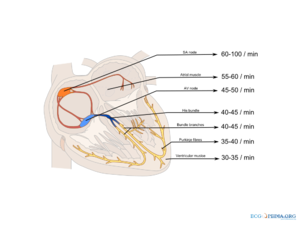Ectopic Complexes
| Author(s) | J.S.S.G. de Jong | |
| Moderator | J.S.S.G. de jong | |
| Supervisor | ||
| some notes about authorship | ||
The pacemaker cells in the sinus node are not the only cells in the heart that can depolarize spontaneously. Actually all cardiomyoctyes have this capacity. The only reason why the sinusnode 'rules' is that it is the fastest pacemaker of the heart. From sinusnode to ventricle all healthy cardiomyocytes can function as a ectopic pacemaker. Ectopic pacemaker activity can originate from the atria (60-80 bpm), AV-node (40-60 bpm) and the ventricles (20-40 bpm). So, as the sinus rate drops (e.g. during atrial infarction), other cells can take over. The configuration of ectopic beats or extrasystoles, as seen on the ECG, reveals its origin, whether they are atrial, nodal or ventrical.


Ectopic pacemakers
| Celltype | Frequency | QRS width (*) |
|---|---|---|
| SA node (not ectopic) | 60-100 bpm | narrow |
| Atrial | 55-60 bpm | narrow |
| AV Nodal ectopic pacemaker | 45-50 bpm | narrow |
| His bundle | 40-45 bpm | narrow |
| Bundle branch | 40-45 bpm | narrow or wide |
| Purkinje cells | 35-40 bpm | wide |
| Myocardial cells | 30-35 bpm | wide |
(*) QRS width can only be narrow if the conduction system downstream is normal (i.e. no bundle branch block)
Compensatory or noncompensatory pause
De duur van de pauze die ontstaat na een extrasystole kan helpen bij het onderscheid tussen een ventrikelextrasystole en een boezemextrasystole.
Non-Compensatoire pauze, bij een boezemextrasystole
Wanneer sinusknoop van buiten geactiveerd wordt door een boezemextrasystole, volgt er een reset van de pacemakercellen in de sinusknoop. Bij een frequentie van bijvorbeeld 60/min, gaan de pacemakercellen 1 seconde na de reset weer vuren, zoals ze ook gewend waren te doen vóór de reset. De tijd tussen de extra slag en het volgende QRS complex is in dit voorbeeld dus 1 seconde. Het geheel van normale slag - extra slag - normale slag is korter dan wanneer je gewoon drie sinusslagen achter elkaar hebt, dit heet een non-compensatoire pauze en is dus een kenmerk van een boezemextrasystole.
Compensatoire pauze, bij een ventrikelextrasystole
Bij een ventrikelextrasystole geleid het signaal over het algemeen niet terug via de AV knoop naar de boezems. De pacemakercellen in de boezems worden dus niet gereset. Het eerstvolgende sinussignaal valt op een moment dat de kamers nog bezig zijn met de ventrikelextrasystole, pas de slag daarna wordt weer voortgeleid. De tijd tussen de ventrikelextraystole en de volgende slag is dus langer! Dit heet een compensatoire pauze. Het oorspronkelijke sinusritme is gewoon door te passeren voorbij de ventrikelextraystole. Dit is dus en kenmerk van een ventrikelextrasystole zonder retrograde geleiding.
Parasystole
Parasystole is the phenomenon that two pacemakers compete. Usually normal sinusrhythm and a secondary pacemaker.
